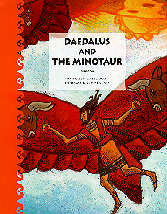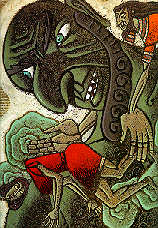


|
Daedalus and the Minotaur.
Priscilla Galloway. Illustrated by Normand Cousineau. Subject Headings:
Grades 5 - 9 / Ages 10 - 14.
***1/2 /4
|

Galloway's recreation shows events and people from the old story in new guises which, as she explains, "puts flesh on old bones." The chilling ruthlessness of King Minos and Queen Parsifay, balanced against the difficult relationship of a brilliant and single-minded father and his son, gives the story a satisfying depth and breadth. An "Afterword" provides young readers with excellent information about the Minoans and various
sources of the classical story. It is followed by an annotated reading list, including web-sites, for those who want to delve deeper into mythology.
Normand Cousineau's richly textured ink and gouache illustrations capture the flavour and style of Minoan art. They are a perfect complement to Galloway's story. Daedalus and the Minotaur is an excellent read-aloud choice for 9 to 12 year olds and is surely to be appreciated by teachers who explore Greek myths with their older students. Librarians who have a copy of Jane Yolen's Wings, published in 1991, could have students compare her wonderful and quite different version with Galloway's recreation.
Highly recommended.
Valerie Nielsen is teacher-librarian at Bairdmore School in Winnipeg, Manitoba.
To comment on this title or this review, send mail to cm@umanitoba.ca.
Copyright © 1998 the Manitoba Library Association.
Reproduction for personal use is permitted only if this copyright notice
is maintained. Any other reproduction is prohibited without
permission.
Published by
TABLE OF CONTENTS FOR THIS ISSUE - MARCH 13, 1998.
AUTHORS |
TITLES |
MEDIA REVIEWS |
BACK ISSUES |
SEARCH |
ORDER |
CMARCHIVE |
HOME Priscilla Galloway describes the stories in her on-going series of illustrated novels, "Tales of Ancient Lands," as "the underpinnings of western literature." She believes that they must be recreated in versions that respect both the modern young reader and the ancient tale. There is no doubt that Galloway's third book in this series, a re-working of the Greek myth, Daedalus and the Minotaur, fulfills both these criteria. The author retells the story of Athenian inventor Daedalus who flees to Crete with his young son, Icarus, after being accused of murdering his nephew, Talos. At the royal court of Crete, Daedalus is plunged into dangerous intrigue when King Minos orders him to build a labyrinth to hide Queen Passifay's child,
rumoured to be half-man half-bull. Instead of the usual monster, Galloway depicts the Minotaur as a disabled child who has been hidden from infancy by the king and queen. Icarus discovers the truth about the royal son, and the two develop a friendship which puts Icarus in jeopardy. Daedalus fears that, upon completion of the labyrinth, no one who has participated in its construction will be allowed to live. The only chance he has to escape King
Minos' plan is to perfect his "man-kites", the wings that will enable him and Icarus to glide to freedom. In the Galloway version, the wings Daedalus builds are not made of feathers and wax. The author feels that such a great inventor would have designed wings that actually could support a human body, not to soar, but to glide down to the sea. Thus, the usual fate of Icarus as he forgets his mortality and soars, god-like, too close to the sun, (only to fall into the sea as the wax melts), is missing from Galloway's version. The author has focused her story on the relationship between father and son and ends it with a scene of reconciliation and love as the two don their wings in preparation for their escape.
Priscilla Galloway describes the stories in her on-going series of illustrated novels, "Tales of Ancient Lands," as "the underpinnings of western literature." She believes that they must be recreated in versions that respect both the modern young reader and the ancient tale. There is no doubt that Galloway's third book in this series, a re-working of the Greek myth, Daedalus and the Minotaur, fulfills both these criteria. The author retells the story of Athenian inventor Daedalus who flees to Crete with his young son, Icarus, after being accused of murdering his nephew, Talos. At the royal court of Crete, Daedalus is plunged into dangerous intrigue when King Minos orders him to build a labyrinth to hide Queen Passifay's child,
rumoured to be half-man half-bull. Instead of the usual monster, Galloway depicts the Minotaur as a disabled child who has been hidden from infancy by the king and queen. Icarus discovers the truth about the royal son, and the two develop a friendship which puts Icarus in jeopardy. Daedalus fears that, upon completion of the labyrinth, no one who has participated in its construction will be allowed to live. The only chance he has to escape King
Minos' plan is to perfect his "man-kites", the wings that will enable him and Icarus to glide to freedom. In the Galloway version, the wings Daedalus builds are not made of feathers and wax. The author feels that such a great inventor would have designed wings that actually could support a human body, not to soar, but to glide down to the sea. Thus, the usual fate of Icarus as he forgets his mortality and soars, god-like, too close to the sun, (only to fall into the sea as the wax melts), is missing from Galloway's version. The author has focused her story on the relationship between father and son and ends it with a scene of reconciliation and love as the two don their wings in preparation for their escape.
"Jump!" commanded Daedalus Daedalus. "Now, together."
In a great leap, father and son launched themselves into the air.
Galloway expands on this dramatic and unusual ending in her epilogue. In it, she explains that contrary to the idea of the height of Icarus' flight causing his downfall, since the temperature of the air falls one degree Celsius for every 500 feet of altitude, had the son flown higher than his father, he would have been colder, not hotter. The story of the sun's melting the wax on Icarus' wings is clearly mythical, told to warn humans about the deadly danger of overweening pride or "hubris."

The Manitoba Library Association
ISSN 1201-9364